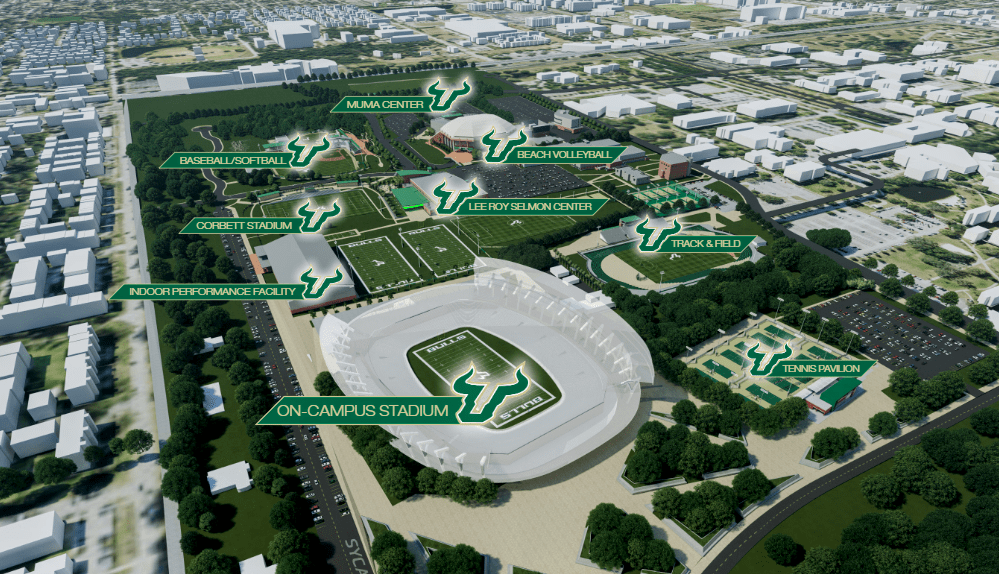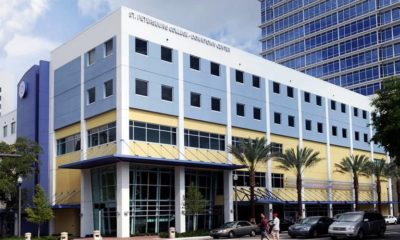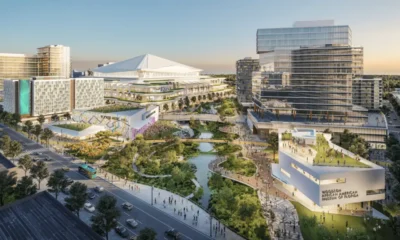Thrive
USF’s stadium plans include borrowing $200 million

The University of South Florida’s pursuit of an on-campus stadium reached another milestone Tuesday as officials unanimously approved its $340 million price tag and a financing plan.
Despite some concerns, the board of trustees finance committee agreed to incur $200 million in debt. The proposal excludes any state funding, tax dollars or university fees.
Fell Stubbs, university treasurer, said the 35,000-seat facility would feature “multiple premium areas” to support the football and new women’s lacrosse teams. He also noted that USF would contribute $140 million.
“This is a continuation of a journey for this very transformative project,” said trustee Michael Griffin. “Certainly, this investment is significant, but an important one.”
The university’s contribution includes $50 million from donations to the USF Foundation, $31 million from the capital improvement trust fund and $59 million from previous and planned broadband licensing sales.
USF officials will borrow the remaining $200 million over 20 years at an estimated fixed interest rate of 5.5%. Stubbs said they would repay the debt using stadium and athletics revenues – comprised of ticket sales, concessions, sponsorships and parking.
While Athletics Director Michael Kelly noted other on-campus facilities sell alcohol, those policies for the new stadium remain undecided.
Background documents show an anticipated attendance of 24,000 per game and state that the facility’s smaller size would create ticket scarcity and propel prices. Officials expect a net income of $15.2 million in the first year – with a target date of 2026 – compared to just $1.8 million at Raymond James Stadium.
Chief Financial Officer Richard Sobieray believes those estimates, compiled by an independent consulting firm, are conservative. He also noted that officials plan to “activate the stadium year-round,” providing “many other opportunities to generate revenue.”
“At the end of the day, I think what we’ve done here is set ourselves up for success,” Sobieray added. “We have looked at other universities and how they built their stadiums, the way they’ve operationalized their stadiums, and we’re learning a lot from them.
“I’m a conservative CFO in nature. If I had issues with this, I would definitely express them.”

An artist’s illustration of a stadium on the University of South Florida’s Tampa campus.
Some committee members did express issues. Trustee Melissa Seixas asked how inflation and rising construction costs could impact the financial plan. Sobieray said they are designing the facility according to its $340 million budget and would adjust plans accordingly.
He also noted the agreement with the Barton Marlow and Populous design-build team includes several contingencies. “Probably more so than we’ve ever done on any other project I’m familiar with,” Sobieray said.
Trustee Jennifer Jasinski Schneider, Faculty Senate president, said school officials could not discern operating or revenue costs until they complete the stadium design. She also wanted to ensure the debt and future costs do not affect academics.
Sobieray replied that he understands “the sensitivity behind” that sentiment but pointed to a 30% increase in state funding due to recent academic achievements. That money, he stressed, would not fund the stadium and would continue supporting education and research initiatives.
“We’ve been really clear that academics is an extremely important priority of the university,” Sobieray added. “And I think the behavior that the university has shown over the last two years proves that.”
Schneider noted USF officials are banking on revenues from a football team that went 1-11 last season and is looking for its first winning record since 2018. While Sobieray reiterated that the plan is to host other events at the facility, like concerts and conferences, he conceded that his colleague was correct.
However, Sobieray – and many other stakeholders – believe an on-campus stadium will boost player recruitment.
“We’ve got to put a winning team on the field,” he said. “Honestly, I think this is going to improve those odds for us.”
USF’s stadium pursuit also took another step forward Tuesday. The committee approved an estimated $17.9 million plan to relocate recreational fields at the site before construction commences in 2024.
While the state Board of Governors must also vote on the plans in August, Griffin said the university’s measured approach is beginning to pay dividends.
“We may not be the quickest, but we do things the right way at USF,” he added.








Geo F
May 24, 2023at3:32 pm
The cost of a college education has increased faster than the rate of inflation for 40 years – the root cause lies with the colleges/universities and their costs-incurred – which included athletics over academics (How much has recently been spent for a new Physics laboratory, Biology laboratory or International Business Studies Program versus a $340M stadium??), not student loan programs or anything else. The accountablility lies with the colleges/universities, not the students, US Govt or taxpayers, or student loan forgiveness.